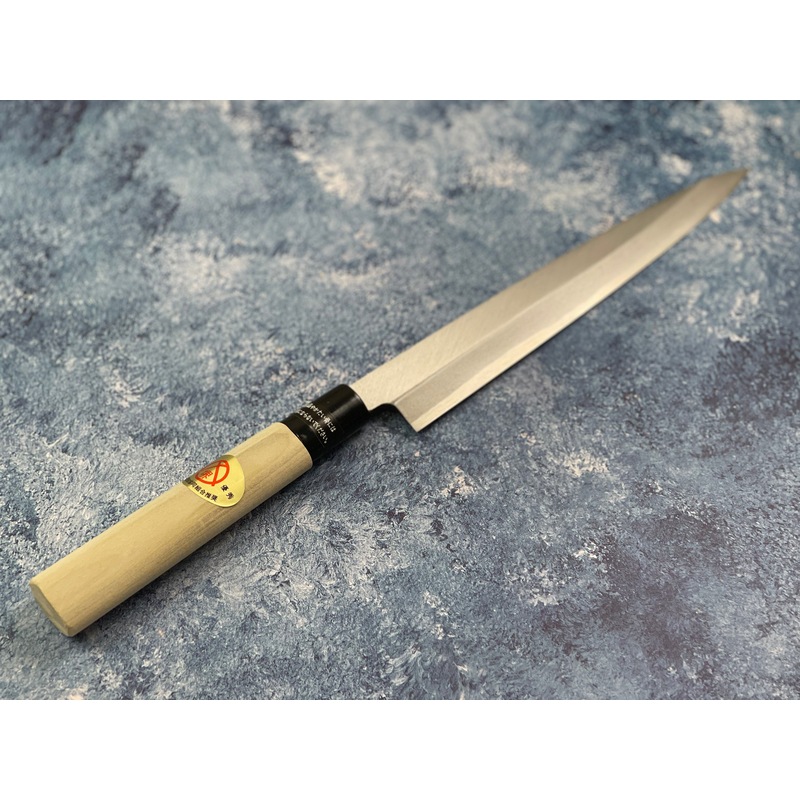














Yanagiba knives are primarily used to slice boneless fish fillets for Sashimi and Sushi dishes, but they can also be used to fillet small to medium-sized fish and are often used for skinning fish.
Aogami Super Blue steel is considered to be the best carbon steel for knife making if you want insanely sharp knives. Japanese steels are commonly known by the colour that the label wrapped around the steel happens to be (white, blue, super blue). In this case it's super blue steel, also known as Aogami Super Blue.
Super is Steel is a fantastic knife steel. Made up of Carbon: 1.40 – 1.50%, Tungsten: 2.00 – 2.50%, Vanadium: .30 - .50%, Chromium: .30 - .50%, Molybdenum: .30 - .50%, Manganese: .20 - .30%, Phosphorus: .025%, Sulfur: .004%, Silicon: .10 - .20% This is one of the most popular high carbon steel alloys amongst Japanese knife makers. It is known for the very high edge retention and fine edge it is capable of. Wear resistance is medium so it is very easy to sharpen. It is very reactive so wiping down and drying should be done after every use.
Tomita is the owner of a small factory in Miki. He is the third generation continuing this art. With his son, he forges various blades entirely by hand. Passionate about his work, he is constantly seeking new materials and innovating with unique designs. He uses a variety of steels and finishing touches, but always maintains the traditional methods and techniques that have been used for decades. He has many lines of knives, of very high quality and finely crafted finishing.
A port town to the south of Osaka in the Kansai area.
Sakai's blacksmiths have been famous in Japan since the third century, during which Japan's blacksmiths came together for construction of the great Imperial burial mounds known as "Kofun."
Later, around 1540, the first knives were produced for cutting tobacco leaves, at the request of the Portuguese. The cleavers quickly became famous for their sharpness, and Sakai became synonymous with quality.
Sakai's blacksmiths have been working together since the beginning, sharing different manufacturing processes. It is this unique feature that explains why Sakai's blacksmiths still carry the names of ancient families and associations of blade makers. People also speak of "Sakai uchi hamono," which translates literally as "blades struck/forged in Sakai."
Most often, the blades are traditional, made from carbon steel, with beveled blades and cypress handles.
Overall Length: 350mm
Blade Length: 205mm
Blade Thickness: 0.4mm
Brand : Tomita
Style: Fully Forged, Full Tang
Bevel: Single Bevel
Steel: Aogami Super Blue steel
Hardness: 61-65 HRC
Handle Material: Magnolia wood
Weight: around 250Grams
Made in: Japan 🇯🇵
Change of Mind Returns:
We want you to love your product so if you are not completely satisfied with your purchase let us know. If at any time within the first 30 days from purchase date you are not completely satisfied with your order, please contact us via your Account for return approval. Once received and inspected, we will facilitate an agreed resolution.
Please Note:
Postage is paid by the customer
The item includes any original packaging. The return must be returned with the original packaging in new condition, accessories included. We recommend packing items carefully to ensure that they are not damaged in transit
We do not accept responsibility for return items until they reach us, so we strongly recommend using tracking and/or insurance for the delivery
Fees may apply
Estimated Delivery Time Frame: 7 - 10 days business days
Warraty Claims:
Most of our products are supported by a 30 days warranty. This warranty covers all manufacturer faults with the product. Some of our products may have a different warranty period, please check the product description for this.
Should an issue arise with our order, please contact us via your account to raise a warranty claim.
Blade had a very small chip in a corner but its not an issue knife is super sharp
Jan 02, 2023